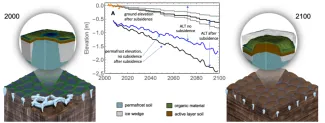Ground Subsidence in Arctic Tundra is Unlikely to Trigger Abrupt Thaw
Drying of tundra landscapes will limit subsidence-induced acceleration of permafrost thaw.
We addressed one of the biggest uncertainties about how carbon-rich regions of the Arctic will respond to warming temperatures: the potential for uneven ground subsidence to accelerate permafrost thaw in a positive feedback loop.
We extended the Advanced Terrestrial Simulator (ATS) permafrost thermal hydrology model to represent uneven sinking of the ground surface caused by melting of ground ice. That process has been observed to accelerate permafrost thaw over small areas, but models were lacking to evaluate the potential impacts over larger scales. Our spatially resolved simulations focused on tundra containing wedge-shaped deposits of ice, a common feature in the Arctic landscape, and our cryo-hydrology simulations were informed by data from a representative site.
Simulation results for a tundra site that is representative of large swaths of the Alaska North Slope suggest that landscape drying will limit the effect of subsidence and prevent abrupt thaw over large areas. However, subsidence increases landscape runoff, which helps maintain streamflow despite increased evapotranspiration but also causes drier tundra conditions that could have deleterious effects on sensitive arctic wetland ecosystems.
Projections of permafrost thaw and thermokarst development for a polygonal tundra site near Utqiaġvik, Alaska. The middle panel shows projected ground elevation and permafrost elevation with (black) and without (blue) subsidence. The single-polygon geometric models shown on the left (early 21st century) and right (2100) were constructed by postprocessing simulation results to illustrate the evolution from poorly drained low-centered polygons to high-centered polygons with well-defined troughs. The larger-scale images are artist renderings of how microtopographic evolution may affect the landscape.
This research was supported by the Director, Office of Science, Office of Biological and Environmental Research of the US Department of Energy under Contract No. DE-AC02-05CH11231 as part of the Next-Generation Ecosystem Experiments (NGEE Arctic) project.
For more information, please contact:
Scott Painter
paintersl@ornl.gov

